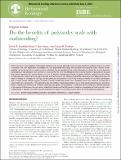Files in this item
Do the benefits of polyandry scale with outbreeding?
Item metadata
| dc.contributor.author | Burdfield-Steel, Emily Rose | |
| dc.contributor.author | Auty, Sam | |
| dc.contributor.author | Shuker, David Michael | |
| dc.date.accessioned | 2015-07-01T10:40:05Z | |
| dc.date.available | 2015-07-01T10:40:05Z | |
| dc.date.issued | 2015-09 | |
| dc.identifier | 195568826 | |
| dc.identifier | fe2c40e3-c83b-481e-9548-9ed6468148a1 | |
| dc.identifier | 84941659483 | |
| dc.identifier | 000361373500027 | |
| dc.identifier.citation | Burdfield-Steel , E R , Auty , S & Shuker , D M 2015 , ' Do the benefits of polyandry scale with outbreeding? ' , Behavioral Ecology , vol. 26 , no. 5 , pp. 1423-1431 . https://doi.org/10.1093/beheco/arv103 | en |
| dc.identifier.issn | 1045-2249 | |
| dc.identifier.uri | https://hdl.handle.net/10023/6891 | |
| dc.description.abstract | There have been many potential explanations put forward as to why polyandry often persists despite the multiple costs it can inflict on females. One such explanation is avoidance of costs associated with mating with genetically incompatible males. Genetic incompatibility can be thought of as a spectrum from individuals that are genetically too similar (inbreeding) to those that are too dissimilar (outbreeding or hybridization). Here we look for evidence that the level of outbreeding influences the benefits of polyandry in the seed bug Lygaeus equestris. Our system allows us to test for benefits of polyandry at levels of genetic similarity ranging from full siblings to heterospecifics, both in terms of egg production and hatching success. We found that while outbreeding level appeared to have no effect on fitness for intra-specific matings, and polyandry did not appear to result in any increase in fertility or fecundity, hybridization with a closely-related species, L. simulans, carried considerable fitness costs. However, these costs could be rescued with a single mating to a conspecific. Thus, polyandry may be beneficial in populations that co-occur with closely-related species and where there is reproductive interference. However, within-species genetic incompatibility is unlikely to be the driving force behind polyandry in this species. Furthermore, the mechanism underlying this rescue of fertility remains unclear as manipulation of male cuticular hydrocarbon profile, a possible mechanism by which females can assess male identity, had no effect on female offspring production. | |
| dc.format.extent | 9 | |
| dc.format.extent | 790635 | |
| dc.language.iso | eng | |
| dc.relation.ispartof | Behavioral Ecology | en |
| dc.subject | Polyandry | en |
| dc.subject | Reproductive interference | en |
| dc.subject | Sexual selection | en |
| dc.subject | Genetic compatability | en |
| dc.subject | QH426 Genetics | en |
| dc.subject.lcc | QH426 | en |
| dc.title | Do the benefits of polyandry scale with outbreeding? | en |
| dc.type | Journal article | en |
| dc.contributor.sponsor | NERC | en |
| dc.contributor.institution | University of St Andrews. School of Biology | en |
| dc.contributor.institution | University of St Andrews. Scottish Oceans Institute | en |
| dc.contributor.institution | University of St Andrews. Institute of Behavioural and Neural Sciences | en |
| dc.contributor.institution | University of St Andrews. Centre for Biological Diversity | en |
| dc.identifier.doi | 10.1093/beheco/arv103 | |
| dc.description.status | Peer reviewed | en |
| dc.identifier.grantnumber | NE/D009979/2 | en |
This item appears in the following Collection(s)
Items in the St Andrews Research Repository are protected by copyright, with all rights reserved, unless otherwise indicated.

